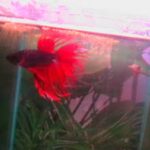Odessa Barb Fact Sheet
The Odessa Barb, Puntius padamya, has been known to the aquarium hobby for many years, but was only described scientifically in 2008. This is referred to in more detail in sources at the end of this article.
The Odessa Barb first came to the attention of the Aquarium Hobby as coming from Odessa in the Ukraine. It is in the group of about 10 species related to the Rosy Barb, Puntius conchonius. Other scientific names the Odessa barb has been called include Puntius ticto.
Although the type specimens of this fish were found in or near the lower Chindwin River in Myanmar, it is generally believed to be more widely distributed than this implies. The good tolerance of this species to low temperatures fits in with the belief that it can come from cooler, mountainous areas such as the foothills of the Himalayas.
Water Conditions
The Odessa Barb prefers cooler water than most tropical fish, 14-25 degrees C. (57-77 degrees F) being ideal. They are happy in either a tropical aquarium at 24 degrees C (75 degrees F) or in an unheated aquarium as long as it is not in an extremely cold area. In warm areas, this fish could be kept outside in ponds, but you would need to consider how cold it would get in the winter in your area.
Although the Odessa barb likes slightly acidic water, they are also happy in neutral or slightly alkaline conditions. A moderate degree of hardness does not seem to bother this fish.
Food
The Odessa Barb is an easily fed omnivore and will eat all normal aquarium foods. The basis of its diet could be a good quality flake or pellet food with the occasional feeding of frozen food like Frozen blood worms or a live food like mosquito larvae or Daphnia.
Companions
The Odessa Barb is a schooling fish, and I suggest that at least 5 be kept together. Although not one of the most aggressive barbs, I would not tend to keep them with slow moving, long finned fish like Guppies or Siamese Fighting Fish.
The Odessa barb is a suitable companion for most of the Barbs, Swordtails, Platies, Rasboras and Tetras as well as the more peaceful larger fish like the Silver Shark, but I would avoid really aggressive fish as their companions.
Sexing
The Male Odessa Barb has a more obvious Red stripe, especially when in breeding condition. The female get plumper when they have eggs.
Breeding
The Breeding of the Odessa Barb is very similar to the breeding of the Rosy Barb. They are an easily spawned egg layer. They eat their own eggs and babies, so if you want a reasonable survival rate, it is necessary to remove the parents after spawning. The ideal water is moderately soft and slightly alkaline, but they do not seem to be too fussy.
Raising the Fry
The Odessa Barb babies are slightly bigger than many of the smaller egg laying aquarium fish. They also grow faster than average. As soon as they are free swimming they are capable of eating finely screened daphnia. A dry fry food like HBH “Fry Bites” or Sera Micropan can be used as the main diet while they are young. Suitable sized live food is a good idea at all stages of the growth of the fish.
Sources
The name Puntius padamya was given to this fishIn the Electronic Journal of Ichthyology
October 2008 2: 56 – 66
“PUNTIUS PADAMYA, A NEW SPECIES OF CYPRINID FISH FROM MYANMAR (TELEOSTEI: CYPRINIDAE)” by Sven O. Kullander of theDepartment of Vertebrate Zoology, Swedish Museum of Natural History, PO Box 50007,
SE-104 05 Stockholm, Sweden. E-mail: [email protected]. And Ralf Britz of theDepartment of Zoology, The Natural History Museum, London, SW7 5BD, United Kingdom.
E-mail: [email protected]. http://ichthyology.tau.ac.il/2008/KullanderBritz.pdf,
http://www.aquaticcommunity.com/barbs/odessabarb.php and http://www.fishlore.com/profile-odessabarb.htm.



